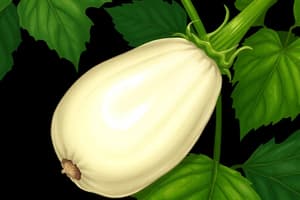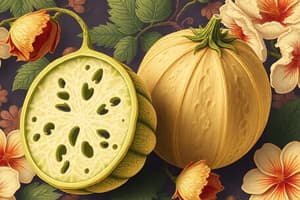Podcast
Questions and Answers
What type of plant is jicama?
What type of plant is jicama?
- Shrub
- Herbaceous (correct)
- Tree
- Woody
Jicama is an annual plant that only lives for one year.
Jicama is an annual plant that only lives for one year.
False (B)
Where was jicama first domesticated?
Where was jicama first domesticated?
Central America
The tuberous root of jicama is harvested from the ______.
The tuberous root of jicama is harvested from the ______.
Match each process of jicama preparation with its description:
Match each process of jicama preparation with its description:
What is the primary economic purpose for which Jatropha (Jatropha curcas) is grown?
What is the primary economic purpose for which Jatropha (Jatropha curcas) is grown?
Jatropha is classified as a perennial plant.
Jatropha is classified as a perennial plant.
What is the first step in the processing of Jatropha seeds to extract oil?
What is the first step in the processing of Jatropha seeds to extract oil?
The seeds of Jatropha are crushed to extract the ______.
The seeds of Jatropha are crushed to extract the ______.
Match the following processing steps of Jatropha oil extraction with their descriptions:
Match the following processing steps of Jatropha oil extraction with their descriptions:
What is the main function of true roots?
What is the main function of true roots?
All underground plant structures are considered root crops.
All underground plant structures are considered root crops.
Name one example of a tuber.
Name one example of a tuber.
The important food bulbs primarily belong to the genus __________.
The important food bulbs primarily belong to the genus __________.
Match the following types of underground crops with their descriptions:
Match the following types of underground crops with their descriptions:
What was a major factor that made the potato crop susceptible to potato blight?
What was a major factor that made the potato crop susceptible to potato blight?
Potatoes are about 80% protein and contain significant amounts of vitamins.
Potatoes are about 80% protein and contain significant amounts of vitamins.
What is the primary economic importance of yams in tropical regions?
What is the primary economic importance of yams in tropical regions?
The potato is part of the ______ family.
The potato is part of the ______ family.
Match the following yam varieties with their characteristics:
Match the following yam varieties with their characteristics:
Which statement about cassava is true?
Which statement about cassava is true?
Sweet potatoes are often mistakenly labeled as yams in North American supermarkets.
Sweet potatoes are often mistakenly labeled as yams in North American supermarkets.
What is poi made from?
What is poi made from?
The taproots of biennial species store carbohydrates during their first year and are harvested in early ______.
The taproots of biennial species store carbohydrates during their first year and are harvested in early ______.
Match the following root-related crops with their main characteristics:
Match the following root-related crops with their main characteristics:
What was one of the initial uses of spices in food?
What was one of the initial uses of spices in food?
Marco Polo's expeditions introduced spices from Europe to Asia.
Marco Polo's expeditions introduced spices from Europe to Asia.
What major event during the Crusades allowed Venice to become a main distributor of spices?
What major event during the Crusades allowed Venice to become a main distributor of spices?
The chemical substances that contribute to the flavors and aromas of spices are mainly called __________.
The chemical substances that contribute to the flavors and aromas of spices are mainly called __________.
Match the following historical events with their significance in the spice trade:
Match the following historical events with their significance in the spice trade:
Who discovered the alternative sea trade route from Europe to India and East Asia?
Who discovered the alternative sea trade route from Europe to India and East Asia?
The British and Dutch completely eliminated the Portuguese East India Company's control over spice trade in the 1600s.
The British and Dutch completely eliminated the Portuguese East India Company's control over spice trade in the 1600s.
What is one of the primary uses of essential oils extracted from Mint Family plants?
What is one of the primary uses of essential oils extracted from Mint Family plants?
The leaves of _____ are widely used in Italian cooking, especially in pizza and pasta sauces.
The leaves of _____ are widely used in Italian cooking, especially in pizza and pasta sauces.
Match the following Mint Family spices with their descriptions:
Match the following Mint Family spices with their descriptions:
What is a common culinary use of sage?
What is a common culinary use of sage?
Basil is a herb that was first domesticated in Europe.
Basil is a herb that was first domesticated in Europe.
The main ingredient in pesto sauce is ______ leaves.
The main ingredient in pesto sauce is ______ leaves.
Match the following herbs with their primary usage:
Match the following herbs with their primary usage:
Flashcards
Jicama family
Jicama family
The plant family Pachyrhizuserosus belongs to.
Jicama type of plant
Jicama type of plant
Jicama is a herbaceous herb that is perennial.
Jicama origin
Jicama origin
The location where jicama was first cultivated.
Jicama main growing areas
Jicama main growing areas
Signup and view all the flashcards
Jicama processing steps
Jicama processing steps
Signup and view all the flashcards
Jatropha family
Jatropha family
Signup and view all the flashcards
Jatropha plant type
Jatropha plant type
Signup and view all the flashcards
Jatropha use
Jatropha use
Signup and view all the flashcards
Jatropha oil extraction: step 1
Jatropha oil extraction: step 1
Signup and view all the flashcards
Jatropha oil extraction: step 4
Jatropha oil extraction: step 4
Signup and view all the flashcards
Root Crop
Root Crop
Signup and view all the flashcards
Taproot
Taproot
Signup and view all the flashcards
Bulb (vegetable)
Bulb (vegetable)
Signup and view all the flashcards
Vegetable
Vegetable
Signup and view all the flashcards
Green Vegetable
Green Vegetable
Signup and view all the flashcards
Potato origin
Potato origin
Signup and view all the flashcards
Irish Potato Famine cause
Irish Potato Famine cause
Signup and view all the flashcards
Potato propagation method
Potato propagation method
Signup and view all the flashcards
Corm characteristic
Corm characteristic
Signup and view all the flashcards
Taro cultivation
Taro cultivation
Signup and view all the flashcards
Cassava
Cassava
Signup and view all the flashcards
Sweet Potato
Sweet Potato
Signup and view all the flashcards
Taproot
Taproot
Signup and view all the flashcards
Poi
Poi
Signup and view all the flashcards
Biennial Plant
Biennial Plant
Signup and view all the flashcards
Spice use in history
Spice use in history
Signup and view all the flashcards
Spice source chemical
Spice source chemical
Signup and view all the flashcards
Crusades' impact on spices
Crusades' impact on spices
Signup and view all the flashcards
Fourth Crusade impact
Fourth Crusade impact
Signup and view all the flashcards
Spice Trade benefits
Spice Trade benefits
Signup and view all the flashcards
Overland Caravan Trade Route Dangers
Overland Caravan Trade Route Dangers
Signup and view all the flashcards
Vasco da Gama's Sea Route
Vasco da Gama's Sea Route
Signup and view all the flashcards
Portuguese East India Company Monopoly
Portuguese East India Company Monopoly
Signup and view all the flashcards
Mint Family Spices
Mint Family Spices
Signup and view all the flashcards
Rosemary, Thyme, Oregano Use
Rosemary, Thyme, Oregano Use
Signup and view all the flashcards
Marjoram use
Marjoram use
Signup and view all the flashcards
Sage flavor
Sage flavor
Signup and view all the flashcards
Basil origin
Basil origin
Signup and view all the flashcards
Mint family uses
Mint family uses
Signup and view all the flashcards
Perilla use
Perilla use
Signup and view all the flashcards
Study Notes
Jicama (Pachyrhizus erosus)
- Plant family: Fabaceae (pea family)
- Type of plant: Herbaceous vine
- Lifecycle: Perennial (lives longer than 2 years)
- Native to: Mexico and Central America
History as a Food Plant
- First domesticated in Mexico around 3000 BC
- Archaeological sites in Peru date back to 3000 BC.
- Widely grown in Central America and Southeast Asia
- Introduced to Southeast Asia by the Spanish in the 17th century.
- Now popular in the Philippines, China, and other parts of the region.
Utilization
- Part used: Tuberous root (tap root system)
- Processing steps:
- Harvesting: Root is dug from the ground
- Peeling: Thin brown skin is removed
- Cutting: Cut into sticks, cubes, or slices, depending on use.
- Culinary uses:
- Enjoyed raw in salads, salsas, or as a crunchy snack
- Lime juice and chili powder can be added
- Stir-fries, soups, and stews, retaining its crisp texture.
Studying That Suits You
Use AI to generate personalized quizzes and flashcards to suit your learning preferences.




